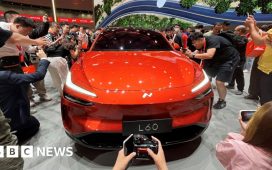To mark the 50th anniversary celebrations of the Hyundai Pony Coupe concept which was first revealed to the world at the 1974 Turin Motor Show, the Korean brand has recreated the original car in partnership with the Pony’s designer, Giorgetto Giugiaro.
The restored Pony Coupe was unveiled at Hyundai‘s Reunion event in Italy, returning to the country where the car was first unveiled. The Pony will also be shown at this weekend’s Concorso d’Eleganza Villa d’Este on Lake Como.
Back in 1974 Hyundai was still in the early days of vehicle production and had no design or styling capability at its headquarters in Korea. It therefore enlisted the help of a then relatively fresh Giorgetto Giugiaro to help design, blueprint and build five Pony prototypes – one of which was a coupe – to announce the arrival of Hyundai as a car builder, promoting the brand’s debut in the global market. The Pony line-up of cars would go on to be a big success for the Korean firm.
Now, nearly 50 years on from the Pony Coupe’s debut, Hyundai has once again called on Giugiaro – and together with his son, Fabrizio, and their company GFG Style – to restore the car to its former glory, using the original specifications and materials.
The Pony Coupe concept’s significance can’t be underestimated. At the time Hyundai was a relatively unknown brand, but the show car signalled its intent. Unfortunate economic conditions in the late seventies meant the model never made production, but its “origami-like” exterior design has inspired plenty of modern Hyundai models since.
The Ioniq 5 and the car that previewed it – the 45 concept – as well as the more recent hydrogen fuel cell-powered N Vision 74 concept were all inspired by the Pony Coupe’s styling.
The seventies show car’s wedge-shaped profile, strong surface treatment (with bumpers painted in the body colour) and cut-off tail might be relatively commonplace design elements today, but in 1973 when the car was first designed, the Pony Coupe was an innovative-looking vehicle.
At 4.1 metres long, the rebuilt Pony Coupe concept is powered by an 81bhp front-mounted 1.2-litre four-cylinder engine, which drives the rear wheels through a manual gearbox. Inside, a single-spoke steering wheel, slim bucket seats and an overall minimalist look to the interior match the exterior styling with simple, clean lines.
Outlining how the original project came about, Giorgetto Giugiaro said: “Hyundai approached us to start a complete redesign of a model, without much experience. I was sceptical at first because I didn’t know Hyundai Motor at that time. We were all impressed by the passion and commitment of the Hyundai engineers. They were sharp, curious, open and extremely eager to learn. They immediately embraced the working methods that were new to them. They sacrificed themselves to make a good impression – for company and their partners. I’m proud and honored to witness how this company has evolved since we first met.”
SangYup Lee, Executive Vice President and Head of Hyundai Design Center, followed Giugiaro’s words: “The Pony Coupe Concept reflects the company’s gratitude and dedication to the challenging spirits that people at Hyundai Motor had back in 1974,” he said.
“The rebirth of the Pony Coupe Concept is a meaningful milestone in the history of Hyundai Motor because it signifies not only our beginnings but also our commitment to the future with our new dreams.”
Now, Hyundai is looking back on its heritage with pride and the brand says we can expect more of this, as it has plans to expand its ‘Hyundai Reunion’, outlined by Hyundai’s global marketing boss, Sungwon Jee.
The Pony Coupe Concept “marks the launch of Hyundai Reunion, our platform for showcasing the brand’s heritage. This is where one can see how our past success still serves as a basis for our daring attitude today. This spirit of innovation can be seen in these two models as well as the people who made them possible.”
Now read our review of the Hyundai N Vision 74 concept…







